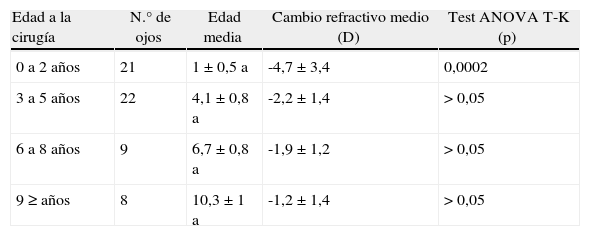Evaluar la predictibilidad de la refracción postoperatoria y la evolución refractiva en pseudofaquia pediátrica.
MétodosTrabajo prospectivo, longitudinal, en operados de catarata con lente intraocular, menores de 15 años, con 5 años continuos de seguimiento. Los pacientes fueron divididos según la edad en años al momento de la cirugía: grupos de 0 a 2 años, de 3 a 5 años, de 6 a 8 años y de 9 o más años. Se estudiaron error de predicción y cambio refractivo. Se realizó el análisis estadístico aplicando t de Student, test de Anova.
ResultadosSe incluyeron 60 ojos (44 pacientes). Sin diferencias significativas entre grupo unilateral y bilateral. El error de predicción fue de 1,5±1,8 D en el grupo de 0 a 2 años, significativamente mayor que en los otros grupos (ANOVA p = 0,01). El cambio refractivo a los 5 años del grupo de 0 a 2 años fue de -4,7±3,4 D, (ANOVA p = 0,0002) mientras en los otros grupos fue significativamente menor y sin diferencias entre grupos.
ConclusionesEl grupo de 0 a 2 años resultó menos hipermétrope de lo esperado, con un 100% dentro de lo aceptado de dos desviaciones estándar, pero con alta variabilidad. El cambio refractivo observado en este grupo coincide con trabajos previos en los que el mayor crecimiento y el aumento de la longitud axial ocurre durante los primeros dos años. El cálculo y utilización de una LIO en niños tiene mejor predicción refractiva inmediata y, a largo plazo, en mayores de 2 años de edad.
Evaluate the predictability of the postoperative refraction and refractive changes in pediatric pseudophakia.
MethodsProspective, longitudinal follow-up on patients under the age of 15 years operated on for a cataract with intraocular lens, with 5 continuous years of follow-up. The patients were divided into 4 groups according to age at the time of the surgery: group from 0 to 2 years old, from 3 to 5 years old, from 6 to 8 years old, and 9 years and over. Error prediction and refractive change were studied. Statistical analysis was performed using the Student t and ANOVA test.
ResultsA total of 60 eyes were included (44 patients). No significant differences were found between the unilateral and bilateral group. The prediction error in the 0 to 2 years group was 1.5±1.8 D, significantly higher than in the other groups (ANOVA P=.01). Refractive change in 5 years of the group of 0 to 2 years was -4.7±3.4 D (ANOVA P=.0002), while in the other groups it was significantly lower, with no differences between them.
ConclusionsThe 0 to 2 years group was less hyperopic than expected, 100% within the accepted of 2 standard deviations, but with a high variability. The refractive change observed in this group coincides with previous reports that the largest growth and increase in axial length occurs during the first 2 years. The calculation and use of an IOL in children has a better immediate refractive prediction, and at long term in those older than 2 years of age.
Artículo
Comprando el artículo el PDF del mismo podrá ser descargado
Precio 19,34 €
Comprar ahora









